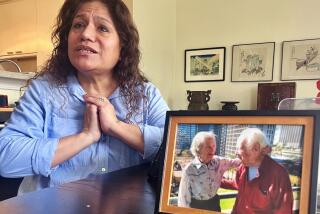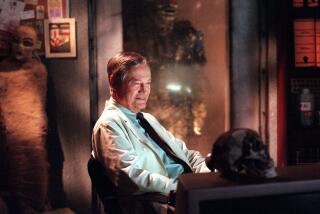Samuel Z. Arkoff, 83; Produced Many Teen Movies
- Share via
Horror. Beach bunnies. Youth. Sex. Drugs. Exploitation. Action, action and more action.
It all added up to big box office and bigger profits, and later evolved into cult classics spun from an innovative, trend-setting vision.
Samuel Z. Arkoff, the offbeat producer responsible for all of that, as exemplified in his hundreds of films from “I Was a Teen-Age Werewolf” to “The Amityville Horror,” has died. He was 83.
Arkoff died Sunday in Providence St. Joseph’s Medical Center in Burbank of natural causes, his family said.
His motto was, “Thou shalt not put too much money into one picture. And with the money you do spend, put it on the screen. Don’t waste it on the egos of actors or nonsense that might appeal to highbrow critics.”
The man who specialized in quickie B movies with quirky titles lived to see himself become a legend, with a retrospective of his work at the Museum of Modern Art in New York City and such awards as Producer of the Year, Master Showman of the Decade and Pioneer of the Year from motion picture associations and a Commendatore of the Order of Merit from Italy.
American Movie Classics interviewed Arkoff earlier this year and saluted him and his studio in a documentary narrated by AIP alumnus Peter Bogdanovich, “It Conquered Hollywood: The Story of American International Pictures.”
“I suppose time can dignify anything,” Arkoff told The Times in 1982, amused by his newfound respectability.
The cigar-chomping Iowa farm boy was an Army cryptographer during World War II who went on to earn a law degree from Los Angeles’ Loyola University. He loved movies and naturally drifted into entertainment law, then producing.
In 1954 he joined with the late James H. Nicholson to create American International Pictures with a $3,000 loan. Art and creativity were not in his sights, though vision and innovation innately were.
“We went into business to make money--for ourselves, for distributors and exhibitors,” he said over and over again.
He saw a teenage and youth culture being ignored by the big studios, and set out to serve it, dishing up action, horror and sex, all tinged with comic effects--whatever the free-spending kids wanted.
“We went by the headlines,” Arkoff told The Times in 1998. “If teenagers were involved in something new, we made a movie about it.”
Unlike bigger studios, Arkoff’s speedy AIP movie machine could skip from fad to fad as fast as teenagers’ tastes.
First up was newcomer Roger Corman’s gritty racing movie “The Fast and the Furious.” Made for $60,000, it grossed $250,000.
Arkoff and his company were off and running.
Soon came “I Was a Teen-Age Werewolf” in 1957 starring Michael Landon. It cost $100,000, took six days to make and grossed $2 million. A typical AIP film cost $300,000 and was shot in a week’s time.
With “The Amityville Horror” in 1979, the company grossed $65 million, and for the next 10 years held the record for the largest grossing independent film.
“I think both Jim Nicholson and Sam Arkoff understood the young market,” Corman told The Times earlier this year. “They had children who were young at the time, and I think that kept them in touch with it.”
One of Arkoff’s most popular series was his uncharacteristically wholesome beach movies, many of them featuring popular singing heartthrob Frankie Avalon and “Mickey Mouse Club” favorite Annette Funicello. Arkoff made 13 of them in the mid-1960s when the Beach Boys’ “Surfin’ USA” and Jan and Dean’s “Surf City” topped the charts.
Arkoff, who said he got the idea from an Italian bohemian film of beach activity, shot each picture in less than two weeks for less than $500,000, and grossed millions.
The mogul’s ability to cater to the ever-changing appetites of the youth market that he moved into Hollywood’s Klieg lights is reflected in the titles of the films that spun off his assembly line:
In the 1950s: “Reform School Girl,” “How to Make a Monster,” “Machine Gun Kelly,” “A Bucket of Blood,” “Diary of a High School Bride,” “The Ghost of Dragstrip Hollow.”
In the 1960s: “The Pit and the Pendulum,” “Panic in Year Zero,” “Bikini Beach,” “Pajama Party,” “The Comedy of Terrors,” “Beach Blanket Bingo,” “Dr. Goldfoot and the Bikini Machine,” “How to Stuff a Wild Bikini,” “The Ghost in the Invisible Bikini.”
In the 1970s: “Angel Unchained,” “Bloody Mama,” “The Dunwich Horror,” “Wuthering Heights,” “The Abominable Doctor Phibes,” “Dillinger,” “Madhouse,” “Cooley High,” “Return to Macon County,” “The Island of Dr. Moreau,” “The People that Time Forgot.”
In the 1980s: Brian De Palma’s chilling “Dressed to Kill,” “How to Beat the High Cost of Living” and “The Final Terror.”
“We often would get the title first,” Arkoff said. “Then we would work up a poster for the picture. If it looked good, we’d go ahead with a script.”
Along the way, he provided early opportunities for talented young directors including Francis Ford Coppola, Martin Scorsese and Woody Allen. He also provided early vehicles for major actors including Jack Nicholson, Robert De Niro, Dennis Hopper, Peter Fonda, Bruce Dern, Cher, Richard Pryor and Nick Nolte.
His strict low-budget edict caused a few problems that might appall today’s well-financed special effects creators.
Arkoff recalled one example for a Times interviewer earlier this year. He said he gave a dubious Corman $29,000 to make the 1955 horror movie “The Beast With a Million Eyes”--only to have Corman omit the beast. When the finished film was turned in, posters had already been distributed publicizing a multi-eyed title character.
“I said, ‘Where is the beast?’ ” Arkoff recalled. “Roger said, ‘I didn’t have any money. You put in the monster.’
“So what we finally did,” the resourceful Arkoff said, “is we got a teakettle and we put about 50 holes in it and got steam going through it. That became our beast with a million eyes.”
In recent years, he was working with his son, Louis, to remake some of his earliest films such as “Teenage Caveman” for HBO.
Arkoff’s career largely wound down in the early 1980s after his meteoric independent studio gradually crumbled. His partner, Nicholson, left the company in 1969 and died in 1972.
Arkoff merged AIP with Filmways International in 1979, and sold his interests to Filmways in 1982. The combined company was sold to Orion Pictures, which went under a few years later.
Arkoff founded a new production company, Arkoff International Pictures, in 1981 but, in an evolving Hollywood, never matched the success he had had with AIP.
In 1992, he published his memoirs, “Flying Through Hollywood by the Seat of My Pants,” written with Richard Trubo.
A former trustee of Loyola Marymount University, Arkoff sponsored the annual Arkoff Awards for best original screenplays and telefilms by Loyola Marymount students. He had also served as vice president of Variety Clubs.
Arkoff’s wife of 55 years, Hilda, died July 26.
He is survived by his children who are also involved in motion picture production: son, Louis; and daughter, Donna Arkoff Roth, wife of Revolution Studios founder Joe Roth; five grandchildren; and one great-grandchild.
Funeral services are scheduled for noon Thursday at Mt. Sinai Memorial Park, 5950 Forest Lawn Drive, Los Angeles.
The family has asked that, instead of flowers, memorial contributions be made to the Samuel Z. Arkoff Scholarship Fund at Loyola Marymount School of Film and Television, in care of the dean, One Loyola Marymount University Drive, Los Angeles, CA 90045.
More to Read
Only good movies
Get the Indie Focus newsletter, Mark Olsen's weekly guide to the world of cinema.
You may occasionally receive promotional content from the Los Angeles Times.










